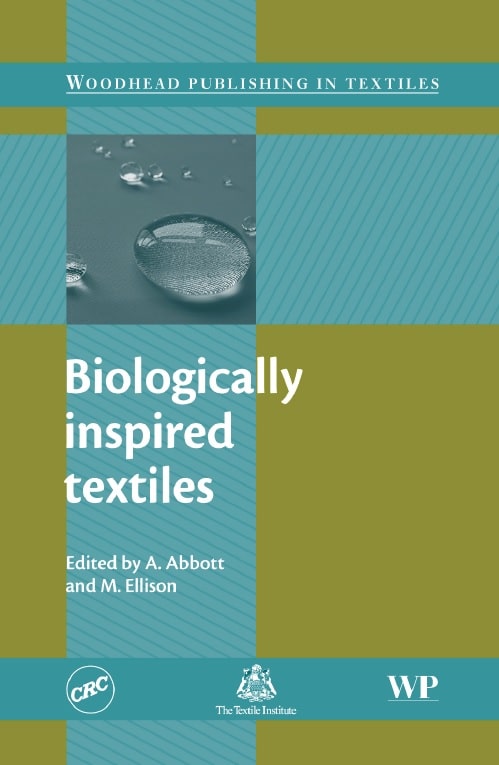
Contents
Contributor contact details xi
Woodhead Publishing in Textiles xiii
Introduction xix
Part I Biomimetic principles, production and properties
1 Recombinant DNA methods applied to the 3
production of protein-based fibers as biomaterials
F. TEULÉ and R. LEWIS, University of Wyoming, USA;
W. MARCOTTE JR and A. ABBOTT, Clemson University, USA
1.1 Introduction 3
1.2 Biomimetics and protein-based biomaterials 4
1.3 Characteristics of some natural protein-based materials 5
1.4 Experimental characterization of model fibrous proteins 9
1.5 Expression systems available for recombinant fibrous 15 protein production
1.6 Artificial material production, properties and performance 20
1.7 Conclusions 20
1.8 References 21
2 Purification of protein solutions 26
S. HARCUM, Clemson University, USA
2.1 Introduction 26
2.2 Insoluble removal 28
2.3 Cell disruption 31
2.4 Soluble protein separations 34
2.5 Finishing steps 42
2.6 Conclusions and sources of further information and advice 43
2.7 References 43
3 Spinning of fibers from protein solutions 44
F. TEULÉ, University of Wyoming, USA
3.1 Introduction 44
3.2 In vivo or natural spinning of protein-based fibers 45
3.3 Protein-based fibrous materials 45
3.4 Silk production in spiders and insects: a natural 47 spinning process
3.5 Elements to consider for the in vitro or ‘artificial’ 51 spinning of protein-based fibers
3.6 Factors involved in native self-assembly processes 52
3.7 ‘Mimicking nature’ 53
3.8 Examples of protein-based fibers produced 55 through artificial spinning technologies
3.9 Wet-spinning of fibrous proteins 55
3.10 Electrospinning of fibrous proteins 60
3.11 Applications 65
3.12 Future trends and conclusions 65
3.13 References 66
4 Biomimetic principles of spider silk for 74 high-performance fibres
C. HOLLAND and F. VOLLRATH, University of Oxford, UK
4.1 Introduction 74
4.2 Unravelling structure–function relationships 77
4.3 Spider and worm spinning in vivo 81
4.4 Spinning in vitro 84
4.5 Future trends and applications 86
4.6 Conclusions 87
4.7 Sources of further information and advice 87
4.8 Acknowledgements 88
4.9 References 88
5 A biomimetic approach to the production of 95
sustainable structural composites using plant fibres
C. SANTULLI, University of Reading, UK
5.1 Biomimetic design of composite materials 95
5.2 Characteristics of biological materials in biocomposites 97
5.3 Fibre extraction, fibre treatment and matrix 99
compatibility in a biomimetic composite
5.4 Approaches to the realisation of plant fibre composites 101
5.5 Conclusions: plant fibre selection for composites 108 reinforcement
5.6 References 109
Part II Biomimetic applications in textiles
6 Biomimetic principles in clothing technology 117
V. KAPSALI and P. DUNAMORE, London College of Fashion, UK
6.1 Introduction 117
6.2 The technology of clothing 118
6.3 Overview of biomimetic design and development 122
6.4 Biomimetic principles and the clothing industry 126
6.5 Key issues 133
6.6 Future trends 133
6.7 Conclusions 134
6.8 Sources of further information and advice 135
6.9 Acknowledgements 135
6.10 References 135
7 Self-cleaning textiles using the Lotus Effect 137
T. STEGMAIER, V. VON ARNIM, A. SCHERRIEBLE
and H. PLANCK, Institute of Textile Technology and
Process Engineering Denkendorf (ITV), Germany
7.1 Introduction: basics of self-cleaning textiles 137
7.2 Learning from the Lotus Effect: superhydrophobicity 138 and self-cleaning
7.3 Measuring techniques for the characteristic 142 Lotus Effect properties
7.4 Technical transfer 143
7.5 Applications 145
7.6 Future trends 148
7.7 Sources of further information and advice 148
7.8 References 149
8 Analysing the thermal properties of 150 animal furs for the production of artificial furs
L. HES, Technical University of Liberec, Czech Republic
8.1 Introduction 150
8.2 Brief survey of the manufacture of artificial furs 151
8.3 Experimental study 152
8.4 Water-vapour permeability of furs 164
8.5 Conclusions 166
8.6 References 167
9 The role of plant stems in providing biomimetic 168 solutions for innovative textiles in composites
M. MILWICH and H. PLANCK, Institute of Textile Technology
and Process Engineering, Denkendorf (ITV), Germany;
T. SPECK and O. SPECK, Universitaet Freiburg, Germany
9.1 Introduction 168
9.2 Composites under development: ‘smart composites’ 172
9.3 Using biomimetics to boost the performance of composites 173
9.4 Learning from a role model: horsetail (Equisetum hyemale) 175
9.5 Learning from a role model: giant reed (Arundo donax) 179
9.6 Learning from a role model: wood 182
9.7 Combination of different principles of role models into 183 the ‘technical plant stem’
9.8 Production methods and machinery equipment for the 183
‘technical plant stem’
9.9 Applications of the ‘technical plant stem’ 188
9.10 Conclusions and future trends 189
9.11 Acknowledgement 190
9.12 References 190
10 Bionic developments based on textile materials 193 for technical applications
T. STEGMAIER, V. VON ARNIM, M. LINKE, M. MILWICH,
J. SARSOUR, A. SCHERRIEBLE, P. SCHNEIDER and
H. PLANCK, Institute of Textile Technology and Process
Engineering Denkendorf (ITV), Germany
10.1 Introduction 193
10.2 Potential of fiber-based materials in bionics 194
10.3 Research activities in the field of surfaces 195
10.4 Research activities in environmental technology 196
10.5 Research activities in energy technology/management 203
10.6 Research activities in the field of lightweight construction 209
10.7 Future trends 210
10.8 Conclusions 210
10.9 Sources of further information and advice 211
10.10 Acknowledgements 211
10.11 References 211
